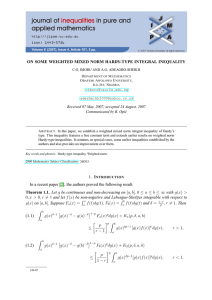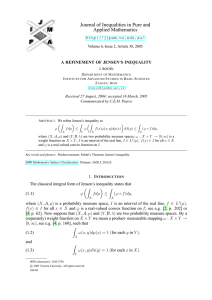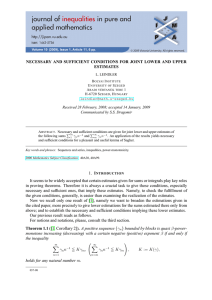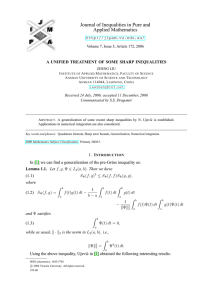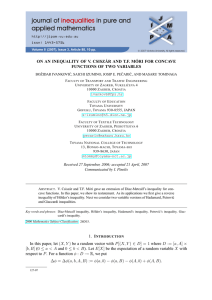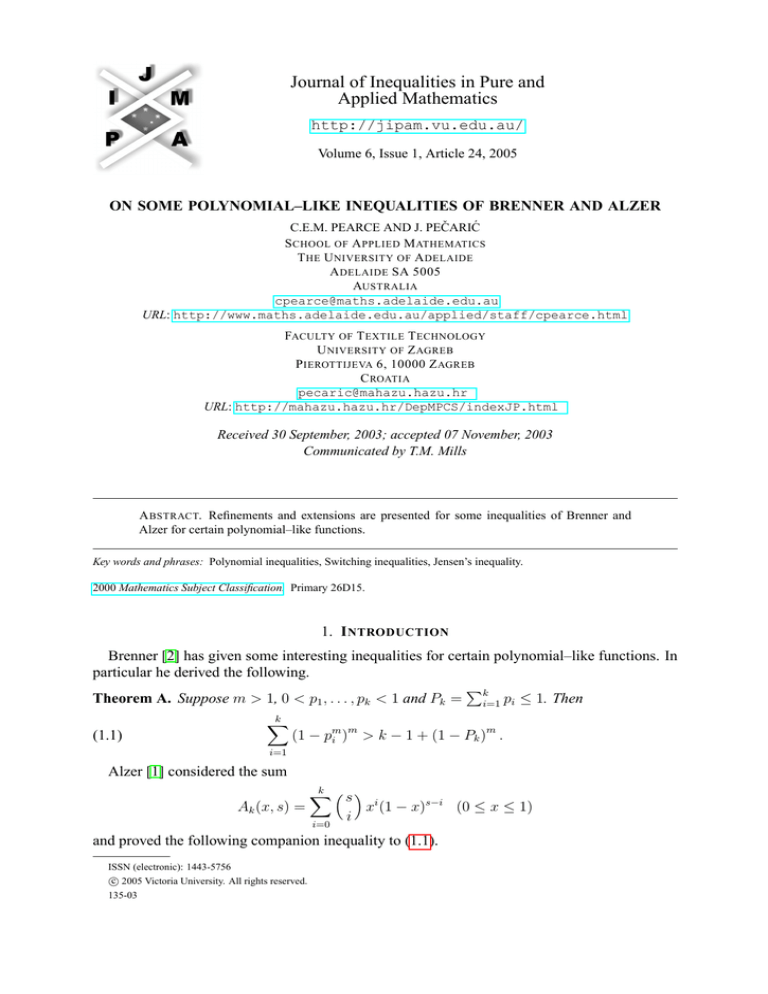
Journal of Inequalities in Pure and
Applied Mathematics
http://jipam.vu.edu.au/
Volume 6, Issue 1, Article 24, 2005
ON SOME POLYNOMIAL–LIKE INEQUALITIES OF BRENNER AND ALZER
C.E.M. PEARCE AND J. PEČARIĆ
S CHOOL OF A PPLIED M ATHEMATICS
T HE U NIVERSITY OF A DELAIDE
A DELAIDE SA 5005
AUSTRALIA
cpearce@maths.adelaide.edu.au
URL: http://www.maths.adelaide.edu.au/applied/staff/cpearce.html
FACULTY OF T EXTILE T ECHNOLOGY
U NIVERSITY OF Z AGREB
P IEROTTIJEVA 6, 10000 Z AGREB
C ROATIA
pecaric@mahazu.hazu.hr
URL: http://mahazu.hazu.hr/DepMPCS/indexJP.html
Received 30 September, 2003; accepted 07 November, 2003
Communicated by T.M. Mills
A BSTRACT. Refinements and extensions are presented for some inequalities of Brenner and
Alzer for certain polynomial–like functions.
Key words and phrases: Polynomial inequalities, Switching inequalities, Jensen’s inequality.
2000 Mathematics Subject Classification. Primary 26D15.
1. I NTRODUCTION
Brenner [2] has given some interesting inequalities for certain polynomial–like functions. In
particular he derived the following.
P
Theorem A. Suppose m > 1, 0 < p1 , . . . , pk < 1 and Pk = ki=1 pi ≤ 1. Then
(1.1)
k
X
m
m
(1 − pm
i ) > k − 1 + (1 − Pk ) .
i=1
Alzer [1] considered the sum
Ak (x, s) =
k X
s
i=0
i
xi (1 − x)s−i (0 ≤ x ≤ 1)
and proved the following companion inequality to (1.1).
ISSN (electronic): 1443-5756
c 2005 Victoria University. All rights reserved.
135-03
2
C.E.M. P EARCE AND J. P E ČARI Ć
Theorem B. Let p, q, m and n be positive real numbers and k a nonnegative integer. If p+q ≤ 1
and m, n > k + 1, then
(1.2)
Ak (pm , n) + Ak (q n , m) > 1 + Ak ((p + q)min(m,n) , max(m, n)).
In the special case k = 0 this provides
(1.3)
(1 − pm )n + (1 − q n )m > 1 + (1 − (p + q)min(m,n) )max(m,n)
for p, q > 0.
In Section 2 we use (1.3) to derive an improvement of Theorem A and a corresponding
version of Theorem B. In Section 3 we give a related Jensen inequality and concavity result.
2. BASIC R ESULTS
Theorem 2.1. Under the conditions of Theorem A we have
k
X
(2.1)
m
m m
(1 − pm
i ) > k − 1 + (1 − Pk ) .
i=1
Proof. We proceed by mathematical induction, (1.3) with n = m providing a basis
(2.2)
(1 − pm )m + (1 − q m )m > 1 + (1 − (p + q)m )m
for p, q > 0 and p + q ≤ 1
for k = 2. For the inductive step, suppose that (2.1) holds for some k ≥ 2, so that
k+1
X
m
(1 − pm
i ) =
i=1
k
X
m
m
m
(1 − pm
i ) + (1 − pk+1 )
i=1
m
> k − 1 + (1 − Pkm )m + (1 − pm
k+1 ) .
Applying (2.2) yields
k+1
X
m
m
m
(1 − pm
i ) > k − 1 + 1 + (1 − (Pk + pk+1 ) )
i=1
m
= k + 1 − Pk+1
m
.
For the remaining results in this paper it is convenient, for a fixed nonnegative integer k and
m > k + 1, to define
B(x) := Ak (xm , m) .
Theorem 2.2. Let p1 , . . . , p` and m be positive real numbers. If
P` :=
`
X
pi ,
i=1
then
(2.3)
`
X
B(pj ) > ` − 1 + B (P` ) .
j=1
Proof. We establish the result by induction, (1.2) with n = m providing a basis
(2.4)
B(p) + B(q) > 1 + B(p + q)
J. Inequal. Pure and Appl. Math., 6(1) Art. 24, 2005
for p, q > 0 and p + q ≤ 1
http://jipam.vu.edu.au/
P OLYNOMIAL – LIKE I NEQUALITIES OF B RENNER
AND
A LZER
3
for ` = 2. Suppose (2.3) to be true for some ` ≥ 2. Then by the inductive hypothesis
`+1
X
B(pj ) =
j=1
`
X
B(pj ) + B(p`+1 )
j=1
> ` − 1 + B(P` ) + B(p`+1 ).
Now applying (2.4) yields
`+1
X
B(pj ) > ` − 1 + 1 + B(P` + p`+1 )
j=1
= ` + B(P`+1 )
(2.5)
as desired.
3. C ONCAVITY OF B
Inequality (2.3) is of the form
n
X
f (pj ) > (n − 1)f (0) + f
j=1
n
X
!
pi ,
j=1
that is, the Petrović inequality for a concave function f . A natural question is whether B satisfies
the corresponding Jensen inequality
!
n
n
X
1
1X
(3.1)
B
pj ≥
B(pj )
n j=1
n j=1
P
for positive p1 , p2 , . . . , pn satisfying nj=1 pj ≤ 1 and indeed whether B is concave. We now
address these questions. It is convenient to first deal separately with the case n = 2.
Theorem 3.1. Suppose p, q are positive and distinct with p + q ≤ 1. Then
p+q
1
(3.2)
B
> [B(p) + B(q)] .
2
2
Proof. Let u ∈ [0, 1). For p ∈ [0, 1 − u] we define
G(p) = B(p) + B(1 − u − p).
By an argument of Alzer [1] we have
m k
m
p
0
m−1
m m−1
(3.3)
G (p) =
(m − k)mp
(1 − p )
[g(p) − 1],
k
1 − pm
where
(3.4)
g(p) =
1−u−p
1 − pm
m−1 m−1
1 − (1 − u − p)m
p
k k
(1 − u − p)m
1 − pm
×
1 − (1 − u − p)m
pm
is a strictly decreasing function.
It was shown in [1] that there exists p0 ∈ (0, 1 − u) such that G(p) is strictly increasing on
[0, p0 ] and strictly decreasing on [p0 , 1 − u], so that
G(p) < G(p0 )
J. Inequal. Pure and Appl. Math., 6(1) Art. 24, 2005
for
p ∈ [0, 1 − u], p 6= p0 .
http://jipam.vu.edu.au/
4
C.E.M. P EARCE AND J. P E ČARI Ć
On the other hand, we have by (3.4) that g((1 − u)/2) = 1 and so from (3.3) G0 ((1 − u)/2) = 0.
Hence p0 = (1 − u)/2 and therefore
1−u
for p 6= (1 − u)/2.
G(p) < G
2
Set u = 1 − (p + q). Since p 6= q, we must have p 6= (1 − u)/2. Therefore
p+q
G(p) < G
,
2
which is simply (3.2).
Corollary 3.2. The map B is concave on (0, 1).
Proof. Theorem 3.1 gives that B is Jensen concave, so that −B is Jensen–convex. Since B is
continuous, we have by a classical result [3, Chapter 3] that −B must also be convex and so B
is concave.
The following result funishes additional information about strictness.
P
Theorem 3.3. Let p1 , . . . , pn , be positive numbers with nj=1 pj ≤ 1. Then (3.1) applies. If not
all the pj are equal, then the inequality is strict.
Proof. The result is trivial with equality if the pj all share a common value, so we assume at
least two different values.
We proceed by induction, Theorem 3.1 providing
a basis for n = 2. For the inductive step,
Pn+1
suppose that (3.1) holds for some n ≥ 2 and that j=1 pj ≤ 1. Without loss of generality we
may assume that pn+1 is the greatest of the values pj . Since not all the values pj are equal, we
therefore have
n
1X
pj .
pn+1 >
n j=1
This rearranges to give
"
#
n
n+1
1X
1
n−1X
pj <
pn+1 +
pj .
n j=1
n
n + 1 j=1
Both sides of this inequality take values in (0, 1).
Also we have
" n
(
)#
n+1
n+1
1 X
1 1X
1
n−1X
pj =
pj +
pn+1 +
pj
.
n + 1 j=1
2 n j=1
n
n + 1 j=1
Hence applying (3.2) provides
!
"
n+1
1 X
1
B
pj >
B
n + 1 j=1
2
n
1X
pj
n j=1
!
1
n
+B
(
n+1
n−1X
pn+1 +
pj
n + 1 j=1
)!#
.
By the inductive hypothesis
1X
pj
n j=1
!
)!
"
n
B
n
1X
≥
B(pj )
n j=1
and
B
1
n
(
pn+1 +
n+1
n−1X
n+1
pj
j=1
J. Inequal. Pure and Appl. Math., 6(1) Art. 24, 2005
≥
1
B(pn+1 ) + (n − 1)B
n
1
n+1
n+1
X
!#
pj
.
j=1
http://jipam.vu.edu.au/
P OLYNOMIAL – LIKE I NEQUALITIES OF B RENNER
Hence
n+1
B
1 X
pj
n + 1 j=1
!
AND
" n+1
1 X
>
B(pj ) + (n − 1)B
2n j=1
A LZER
5
n+1
1 X
pj
n + 1 j=1
!#
.
Rearrangement of this inequality yields
n+1
B
1 X
pj
n + 1 j=1
!
n+1
1 X
>
B(pj ),
n + 1 j=1
the desired result.
Remark 3.4. Taken together, relations (2.5) and (3.1) give
!
n
n
X
X
(3.5)
n−1+B
pj <
B(pj ) ≤ nB
j=1
j=1
n
1X
pj
n j=1
!
,
the second inequality being strict unless all the values pj are equal. If
simplifies to
n
X
(3.6)
n−1<
B(pj ) ≤ nB(n−1 ),
Pn
j=1
pj = 1, this
j=1
since B(1) = 0.
For k = 0, (3.5) and (3.6) become (for m > 1) respectively
!m !m
n
n
X
X
m
n−1+ 1−
pj
<
(1 − pm
j ) ≤ n 1−
j=1
and
n−1<
j=1
n
X
n
1X
pj
n j=1
!m !m
m
−m m
(1 − pm
) .
j ) ≤ n(1 − n
j=1
R EFERENCES
[1] H. ALZER, On an inequality of J.L. Brenner, J. Math. Anal. Appl., 183 (1994), 547–550.
[2] J.L. BRENNER, Analytical inequalities with applications to special functions, J. Math. Anal. Appl.,
106 (1985), 427–442.
[3] G.H. HARDY, J. E. LITTLEWOOD
Cambridge (1934).
AND
G. PÓLYA, Inequalities, Cambridge University Press,
[4] J.E. PEČARIĆ, F. PROSCHAN AND Y.L. TONG, Convex Functions, Partial Orderings and Statistical Applications, Academic Press, New York (1992).
J. Inequal. Pure and Appl. Math., 6(1) Art. 24, 2005
http://jipam.vu.edu.au/

